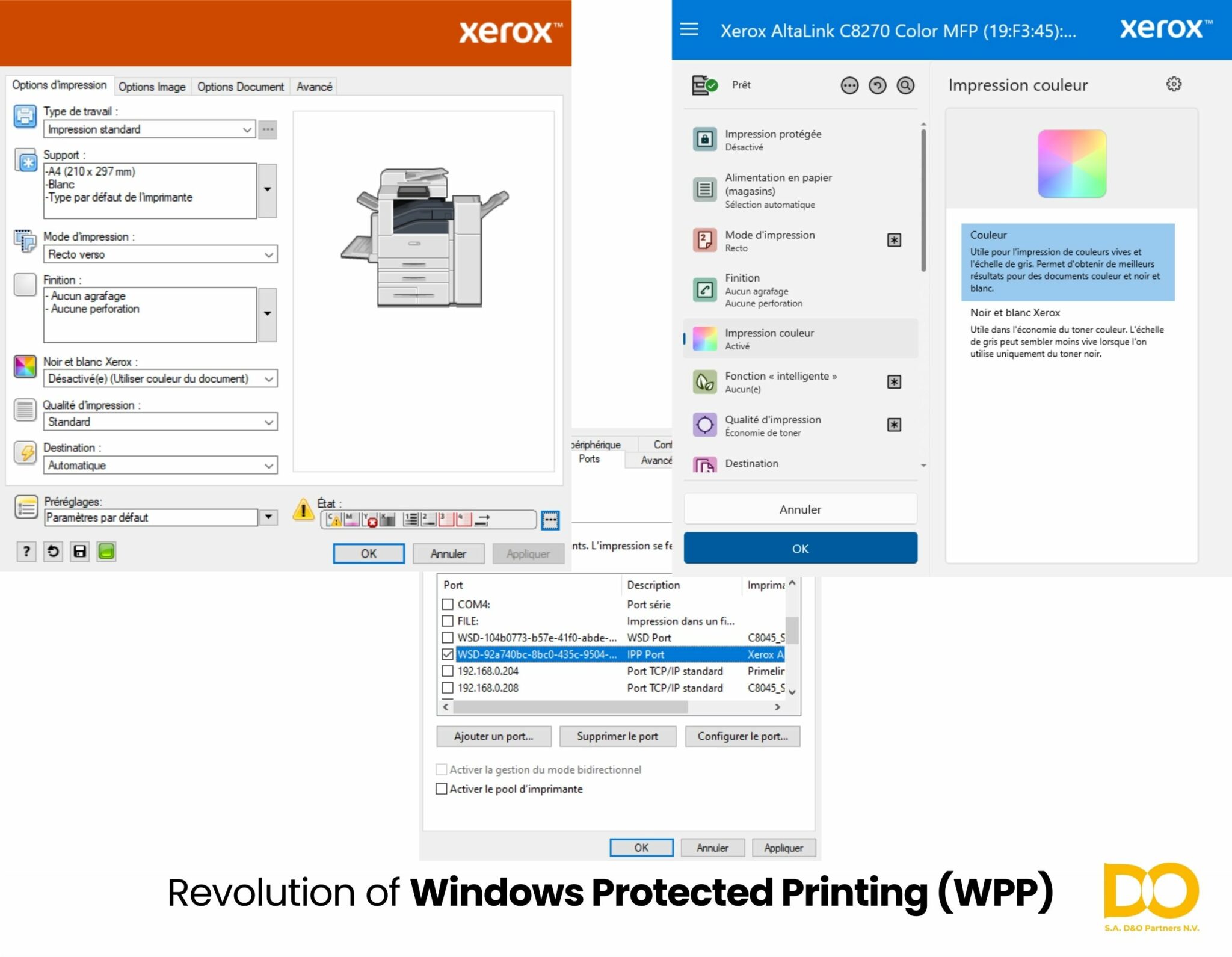At D&O Partners, we attach great importance to keeping our customers informed about major technological developments in the world of printing. One of the most significant changes in the last twenty years is Windows Protected Printing (WPP). But what exactly is WPP, and what does it mean for your printing environment? In this article, we take an in-depth look at the benefits, challenges and implications of WPP for your business.
What is Windows Protected Print Mode?
Windows Protected Printing Mode, or WPP, is a new security update from Microsoft that enables a safer, more efficient printing process. The main feature of WPP is that it works without third-party drivers. This means that traditional drivers, which are often vulnerable to cyber-attacks, become superfluous. By eliminating these drivers, the risk of printer-related security flaws is considerably reduced.
However, unlike Microsoft, which relies on the elimination of third-party drivers, Xerox continues to provide innovative solutions for securing sensitive data, thanks to cutting-edge technologies and features tailored to each company.
The difference between Type 3 and Type 4 drivers
An important aspect of the transition to WPP is the introduction of Type 4 drivers, which replace the old Type 3 drivers. Here are the main differences:
Type 3 Drivers
Type 3 drivers often required full system rights to operate, making them vulnerable to security problems. These drivers depended on third parties such as Xerox to provide additional functionality. While this offered flexibility, it also increased the risk of security breaches, as the drivers were directly integrated into the system.
Type 4 Drivers
With Type 4 drivers, Microsoft has eliminated this dependency. These drivers operate at user level, which means they don’t need system rights. This makes them more secure and less vulnerable to cyber-attacks. In addition, Type 4 drivers support the IPP (Internet Printing Protocol) standard, further enhancing compatibility and performance.
Impact on third parties such as Xerox
For third parties like Xerox, this means they can no longer integrate their own drivers directly into the system. This forces hardware manufacturers to make their printers compatible with Microsoft-imposed standards such as IPP. While this enhances security, it can also impose limitations on certain functionalities that were previously possible with custom drivers.
How does WPP work?
When you activate WPP, a significant change occurs: all existing print queues and drivers are completely deleted. This means you have to reconfigure all your printers and printing options. It’s important to understand that this is an irreversible step; there’s no going back once WPP has been activated. That’s why it’s crucial to be well prepared before making this transition.
WPP uses the IPP standard, which standardizes communication between printers and operating systems. This results in fewer conflicts, faster print jobs and a reduced risk of compatibility problems.
The benefits of WPP
Activating the WPP offers several advantages:
1. Improving safety
By removing third-party drivers, potential entry points for cyber attacks are eliminated. This means a more secure network and reduced risk of data leakage.
2. More efficient printing processes
The IPP standard ensures smooth communication between printers and the operating system, resulting in faster, more reliable print jobs.
3. Preparing for the future
The WPP is designed with the latest technologies, ensuring that your printing environment is ready for the future.
WPP’s potential challenges
Despite its many advantages, WPP also presents a number of challenges. Here are the main points to bear in mind:
Compatibility
Not all printers and finishing options yet support the IPP standard. In particular, older devices or specialized functions, such as stapling or punching, may no longer function once WPP has been activated.
No rollback option
Once WPP has been activated, you cannot revert to the previous configuration. This means you need to be sure of your decision before making the transition.
Reconfiguration
All existing print queues and settings are deleted. This can be time-consuming, especially in large organizations with complex print infrastructures.
What does WPP mean for your company?
At D&O Partners, we understand that the transition to WPP offers both opportunities and challenges. To ensure that your company makes the most of this new technology, we recommend the following:
- Check compatibility: Consider whether your current printers and finishing options are compatible with WPP and the IPP standard.
- Prepare a backup plan: Make sure you have a clear plan for a smooth transition. This includes documenting your current settings and training your employees.
- Ask for professional support: Our experts are ready to help you with advice and assistance in implementing WPP. Together, we’ll ensure a smooth transition.
When will WPP be deployed?
Microsoft has not yet announced an exact launch date, but WPP should be available soon. This gives companies time to prepare and take steps to make their print environments future-ready.
WPP: Your Next Step to a Secure Printing Environment
Windows Protected Print Mode (WPP) marks a new milestone in the evolution of printing technology. With enhanced security, increased efficiency and a focus on modern standards, WPP offers a powerful solution for companies wishing to modernize their printing processes.
At D&O Partners, we’re ready to support you through this change. Whether you need help assessing compatibility, reconfiguring your print environment or simply learning more about WPP, we’re here to help. Don’t hesitate to contact us for personalized advice or further information.

